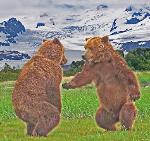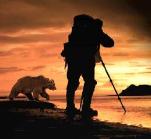| Bear Viewing Association To watch, to wonder, and to conserve [email protected] Ph/Fax (907) 260-9059 (Office) 39200 Alma Ave. Soldotna, AK 99669 |


| Salmon Species, life cycle and and how they nourish bears and bear-habitat |

Salmon life cycles
Salmon Species

There are 5 species of Pacific salmon:
Chinook = king (the largest)
Chum = dog = tiger (next largest)
Coho = silver (mid-sized)
Sockeye = red (a bit smaller than coho)
Pink = humpie (typically the smallest,
although some rival chums in size).
The specimens pictured at left have
migrated out of the ocean, into a stream,
where their bodies lose their silvery marine
color and turn more gaudy in preparation
for mating.
Chinook = king (the largest)
Chum = dog = tiger (next largest)
Coho = silver (mid-sized)
Sockeye = red (a bit smaller than coho)
Pink = humpie (typically the smallest,
although some rival chums in size).
The specimens pictured at left have
migrated out of the ocean, into a stream,
where their bodies lose their silvery marine
color and turn more gaudy in preparation
for mating.
In the photo at right, a female chum salmon is digging
In the photo at right, a female chum salmon is digging
But before she could bury them, a bear passed by, a
nest (redd). She later mated and laid her eggs.
causing both the female and her mate to flee. Just
after this photo was taken, they returned, buried the
eggs in gravel, then guarded them from other fish that
In the photo at right, a female chum salmon is digging
But before she could bury them, a bear passed by, a
nest (redd). She later mated and laid her eggs.
causing both the female and her mate to flee. Just
after this photo was taken, they returned, buried the
eggs in gravel, then guarded them from other fish that


After eggs are fertilized, they begin to develop. The
first distinctive feature to appear is an eye spot. As the
yolk is absorbed, providing energy for the developing
salmon, it begins growing a fish-like body. At this
stage, with the yolk sack still attached, the young
salmon is called an alvin. Alvins live in the gravel bed
where they hatched.
first distinctive feature to appear is an eye spot. As the
yolk is absorbed, providing energy for the developing
salmon, it begins growing a fish-like body. At this
stage, with the yolk sack still attached, the young
salmon is called an alvin. Alvins live in the gravel bed
where they hatched.

Life cycle



Alvins: (a) newly hatched from egg case; (b) living in gravel: (c) leaving gravel and swimming in open water just above the gravel.





Three stages in the development of fry - during which the juveniles tend to hide among rocks, branches, twigs, and plant growth on the
bottom of a creek or lake where current is slow and they find refuge from predators. Meanwhile they eat aquatic insects, tiny zooplankton,
and other prey. As they grow larger, develop vertical stripes known as parr stripes. These provide some camouflage, allowing them to
venture farther from cover in search of prey. At this stage fry are sometimes called parr, as shown at left, below. When they are finally
ready to go out to sea (e.g., into an estuary), they lose their parr stripes and adopt marine coloration (shown at right, below). Their
bottom of a creek or lake where current is slow and they find refuge from predators. Meanwhile they eat aquatic insects, tiny zooplankton,
and other prey. As they grow larger, develop vertical stripes known as parr stripes. These provide some camouflage, allowing them to
venture farther from cover in search of prey. At this stage fry are sometimes called parr, as shown at left, below. When they are finally
ready to go out to sea (e.g., into an estuary), they lose their parr stripes and adopt marine coloration (shown at right, below). Their
Ecological roles of salmon in nourishing bears and their habitat:
Site Visit Counter
